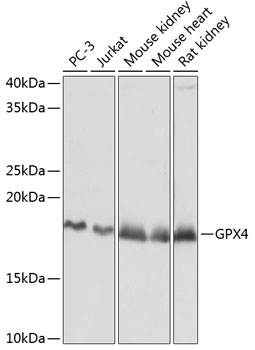Cell Biology Antibodies 16
Anti-GPX4 Antibody (CAB11243)
- SKU:
- CAB11243
- Product Type:
- Antibody
- Reactivity:
- Human
- Reactivity:
- Mouse
- Reactivity:
- Rat
- Host Species:
- Rabbit
- Isotype:
- IgG
- Antibody Type:
- Monoclonal Antibody
- Research Area:
- Cell Biology
Description
| Antibody Name: | Anti-GPX4 Antibody |
| Antibody SKU: | CAB11243 |
| Antibody Size: | 20uL, 50uL, 100uL |
| Application: | WB IP |
| Reactivity: | Human, Mouse, Rat |
| Host Species: | Rabbit |
| Immunogen: | A synthesized peptide derived from human GPX4 |
| Application: | WB IP |
| Recommended Dilution: | WB 1:500 - 1:2000 IP 1:50 - 1:200 |
| Reactivity: | Human, Mouse, Rat |
| Positive Samples: | PC-3, Jurkat, Mouse kidney, Mouse heart, Rat kidney |
| Immunogen: | A synthesized peptide derived from human GPX4 |
| Purification Method: | Affinity purification |
| Storage Buffer: | Store at -20°C. Avoid freeze / thaw cycles. Buffer: PBS with 0.02% sodium azide, 0.05% BSA, 50% glycerol, pH7.3. |
| Isotype: | IgG |
| Sequence: | Email for sequence |
| Gene ID: | 2879 |
| Uniprot: | P36969 |
| Cellular Location: | Cytoplasm, Mitochondrion |
| Calculated MW: | 17kDa |
| Observed MW: | 17KDa |
| Synonyms: | GPx-4, GSHPx-4, MCSP, PHGPx, SMDS, snGPx, snPHGPx |
| Background: | The protein encoded by this gene belongs to the glutathione peroxidase family, members of which catalyze the reduction of hydrogen peroxide, organic hydroperoxides and lipid hydroperoxides, and thereby protect cells against oxidative damage. Several isozymes of this gene family exist in vertebrates, which vary in cellular location and substrate specificity. This isozyme has a high preference for lipid hydroperoxides and protects cells against membrane lipid peroxidation and cell death. It is also required for normal sperm development; thus, it has been identified as a 'moonlighting' protein because of its ability to serve dual functions as a peroxidase, as well as a structural protein in mature spermatozoa. Mutations in this gene are associated with Sedaghatian type of spondylometaphyseal dysplasia (SMDS). This isozyme is also a selenoprotein, containing the rare amino acid selenocysteine (Sec) at its active site. Sec is encoded by the UGA codon, which normally signals translation termination. The 3' UTRs of selenoprotein mRNAs contain a conserved stem-loop structure, designated the Sec insertion sequence (SECIS) element, that is necessary for the recognition of UGA as a Sec codon, rather than as a stop signal. Alternatively spliced transcript variants have been found for this gene. [provided by RefSeq, Oct 2016] |
| UniProt Protein Function: | GPX4: Protects cells against membrane lipid peroxidation and cell death. Required for normal sperm development and male fertility. Could play a major role in protecting mammals from the toxicity of ingested lipid hydroperoxides. Essential for embryonic development. Protects from radiation and oxidative damage. Belongs to the glutathione peroxidase family. 2 isoforms of the human protein are produced by alternative initiation. |
| UniProt Protein Details: | Protein type:Other Amino Acids Metabolism - glutathione; Nuclear envelope; Lipid Metabolism - arachidonic acid; EC 1.11.1.12; Oxidoreductase; Mitochondrial Chromosomal Location of Human Ortholog: 19p13.3 Cellular Component: mitochondrion; nucleus; cytosol Molecular Function:selenium binding; glutathione binding; phospholipid-hydroperoxide glutathione peroxidase activity; glutathione peroxidase activity Biological Process: glutathione metabolic process; lipoxygenase pathway; hydrogen peroxide catabolic process; multicellular organismal development; phospholipid metabolic process; regulation of inflammatory response; arachidonic acid metabolic process; response to oxidative stress; response to estradiol stimulus; aging |
| NCBI Summary: | This gene encodes a member of the glutathione peroxidase protein family. Glutathione peroxidase catalyzes the reduction of hydrogen peroxide, organic hydroperoxide, and lipid peroxides by reduced glutathione and functions in the protection of cells against oxidative damage. Human plasma glutathione peroxidase has been shown to be a selenium-containing enzyme and the UGA codon is translated into a selenocysteine. The encoded protein has been identified as a moonlighting protein based on its ability to serve dual functions as a peroxidase as well as a structural protein in mature spermatozoa. Through alternative splicing and transcription initiation, rat produces proteins that localize to the nucleus, mitochondrion, and cytoplasm. In humans, alternative transcription initiation and the cleavage sites of the mitochondrial and nuclear transit peptides need to be experimentally verified. Alternative splicing results in multiple transcript variants. [provided by RefSeq, Jan 2014] |
| UniProt Code: | P36969 |
| NCBI GenInfo Identifier: | 172045844 |
| NCBI Gene ID: | 2879 |
| NCBI Accession: | P36969.3 |
| UniProt Secondary Accession: | P36969,O43381, Q6PJ59, Q9UPK2, |
| UniProt Related Accession: | P36969 |
| Molecular Weight: | Observed MW: 22kDaCalculated MW: 19kDa/22kDa |
| NCBI Full Name: | Phospholipid hydroperoxide glutathione peroxidase, mitochondrial |
| NCBI Synonym Full Names: | glutathione peroxidase 4 |
| NCBI Official Symbol: | GPX4 |
| NCBI Official Synonym Symbols: | MCSP; GPx-4; PHGPx; snGPx; GSHPx-4; snPHGPx |
| NCBI Protein Information: | phospholipid hydroperoxide glutathione peroxidase, mitochondrial; phospholipid hydroperoxidase; sperm nucleus glutathione peroxidase |
| UniProt Protein Name: | Phospholipid hydroperoxide glutathione peroxidase, mitochondrial |
| UniProt Synonym Protein Names: | Glutathione peroxidase 4; GPx-4; GSHPx-4 |
| Protein Family: | Probable glutathione peroxidase |
| UniProt Gene Name: | GPX4 |
| UniProt Entry Name: | GPX4_HUMAN |





![[KD Validated] GPX4 Polyclonal Antibody [KD Validated] GPX4 Polyclonal Antibody](https://cdn11.bigcommerce.com/s-rd6ounxcu2/images/stencil/590x590/products/81875/86664/A21440_1__66874__21830.1706547009.jpg?c=1)

